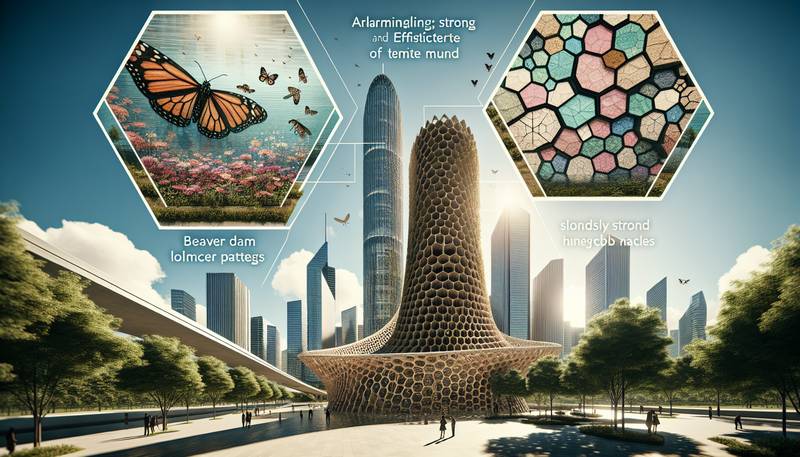Biomimicry in Urban Planning: Learning from Nature's Blueprint

A Humble Beginning: Observing Earth's Original ArchitectsPicture this: it's a sunny afternoon, and you're taking a leisurely stroll through the park, when suddenly, you find yourself captivated by the architectural genius of a beaver dam or the efficient housing structure of a termite mound. From the iridescent wings of a butterfly to the remarkable load-bearing properties of a honeycomb, nature has perfected the art of design through countless millennia of trial and error.Now, I know what you're thinking: what could these wonders of evolution possibly teach us about planning our bustling cityscapes? Well, my inquisitive friend, it turns out that the natural world provides a treasure trove of inspiration for sustainable and efficient urban planning - if only we can learn to tap into its wisdom. This is where biomimicry, the practice of imitating nature's time-tested patterns and strategies, comes into play.From Trees to Skyscrapers: Building with Green in MindImagine living in a city where skyscrapers draw inspiration from the sturdy trunk of a tree, with a central core providing structural support and a network of branches allowing for ample natural light and ventilation. That's precisely the concept behind the Eastgate Center in Harare, Zimbabwe, a building designed to mimic the self-cooling properties of termite mounds. The building uses 90% less energy for ventilation than its conventionally cooled counterparts, saving the tenants a considerable chunk of change on their energy bills.Meanwhile, in the bustling metropolis of Shanghai, urban planners have drawn inspiration from the flexible, yet strong structure of a bird's nest to design the aptly named 'Bird's Nest Stadium.' This lightweight steel structure not only looks stunning but serves as a model for sustainable construction and resource efficiency.Channeling the Wisdom of the Humble Ant: Designing Efficient Transportation NetworksAs any frustrated commuter knows, traffic congestion is a plague that has festered in our cities for far too long. If only there were a way to design a transportation system that could handle the demands of millions of people without grinding to a halt at the mere suggestion of a traffic light malfunction. Enter the humble ant, a creature that has mastered the art of organized chaos, enabling it to navigate complex networks with ease.Researchers have discovered that ants' surprisingly efficient foraging behavior can be applied to our traffic systems, ensuring smoother flows and reducing delays. By analyzing ants' movement patterns, scientists have developed algorithms that can optimize traffic signal timings and the routing of vehicles, ushering in an era of greener and more efficient transportation.Nature's Filter: Cleansing Our Urban WaterwaysAs cities expand and their populations swell, managing water resources becomes an increasingly pressing concern. In a perfect world, we'd have an army of diligent oysters filtering our waterways and purifying our streams. But until we can train these bivalves to do our bidding, we must find other ways to emulate their impressive filtering powers.Inspired by the purification properties of natural systems, a growing number of urban planners are incorporating 'living machines' into their designs. These consist of engineered ecosystems that utilize plants, bacteria, and algae to break down pollutants in wastewater, providing a cost-effective and eco-friendly alternative to conventional water treatment methods.Adaptable Infrastructure: Learning from Nature's ResilienceAs climate change brings increasingly unpredictable weather patterns, our cities must adapt and become more resilient to these shifting conditions. To do so, we can take a leaf from the book of the mangrove tree, which has long thrived in the harshest of coastal environments.These hardy trees have developed an extensive root system that not only anchors them to the ground but also serves as a natural barrier against erosion and storm surges. By mimicking these adaptive strategies, urban planners can design more resilient infrastructure, such as porous pavements that reduce flooding and green roofs that provide insulation and stormwater management.Final Thoughts: Embracing the Wisdom of the WildFrom the soaring heights of a skyscraper to the intricate network of a bustling transportation system, our urban landscapes have much to gain from embracing biomimicry. By studying nature's blueprint and incorporating its time-tested strategies into our designs, we can create cities that are more sustainable, efficient, and resilient than ever before.So the next time you find yourself marveling at the architectural brilliance of a spider's web or the meticulous organization of a beehive, remember that these natural phenomena are not only wonders of the earth but also sources of inspiration for the future of our urban planning.
|
|







